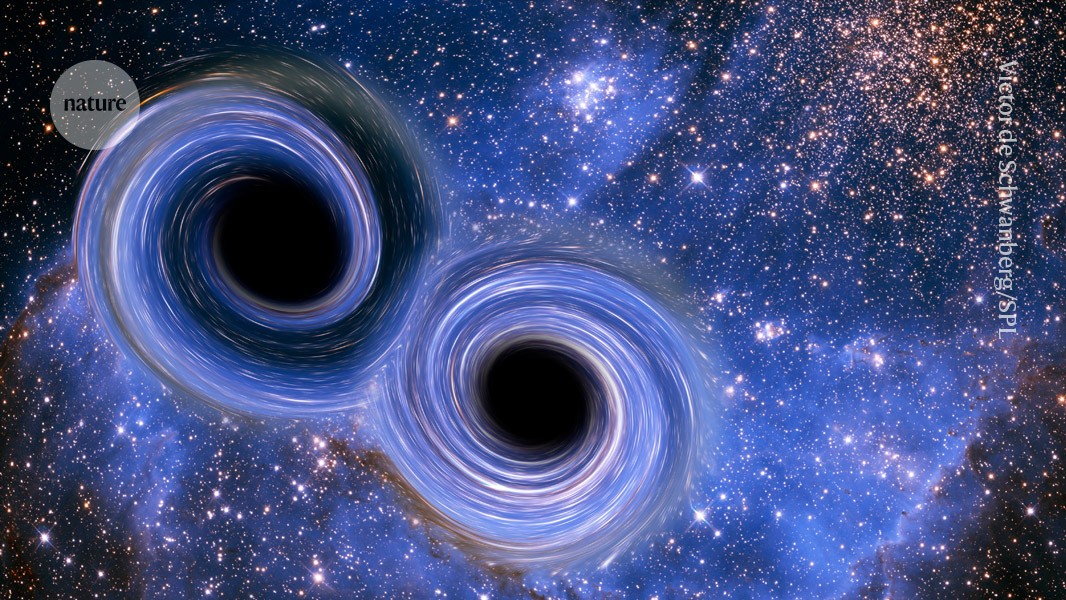Monster black hole merger is biggest ever seen

Gravitational wave detector LIGO spots fast-spinning ‘forbidden’ black holes that challenge physics models

Artist's impression of two black holes merging, which can be detected on Earth through the gravitational waves the collision creates.Credit: Victor de Schwanberg/SPL
Physicists have detected the biggest ever merger of colliding black holes. The discovery has major implications for researchers’ understanding of how such bodies grow in the Universe.
“It’s super exciting,” says Priyamvada Natarajan, a theoretical astrophysicist at Yale University in New Haven, Connecticut, who was not involved in the research. The merger was between black holes with masses too big for physicists to easily explain. “We’re seeing these forbidden high-mass black holes,” she says.
The discovery was made by the Laser Interferometer Gravitational-Wave Observatory (LIGO), a facility involving two detectors in the United States. It comes at a time when US funding for gravitational-wave detection faces devastating cuts. The results, released as a preprint on the arXiv server1, were presented at the GR-Amaldi gravitational-waves meeting in Glasgow, UK, on 14 July.
Forbidden mass
LIGO detects gravitational waves by firing lasers down long, L-shaped arms. Minuscule changes in arm length reveal the passage of gravitational waves through the planet. The waves are ripples in space-time, caused by massive bodies accelerating, such as when two inspiralling black holes or neutron stars merge.
Hundreds of these mergers have been observed using gravitational waves since LIGO's first detection in 2015. But this latest detection, made in November 2023, is the biggest yet. By modelling the signal detected by LIGO, scientists have calculated that the event, dubbed GW231123, was caused by two black holes with masses of about 100 and 140 times that of the Sun merging to form a final black hole weighing in at some 225 solar masses.
“It’s the most massive [merger] so far,” says Mark Hannam, a physicist at Cardiff University, UK, and part of the LVK Collaboration, a wider network of gravitational-wave detectors that encompasses LIGO, Virgo in Italy and KAGRA in Japan. It’s “about 50% more than the previous record holder”, he says.
Most of the events captured by LIGO involve stellar mass black holes — those ranging from a few to 100 times the mass of the Sun — which are thought to form when massive stars end their lives as supernovae. However, the two black holes involved in GW231123 fall in or near a predicted range, of 60–130 solar masses, at which this process isn’t expected to work, with theories instead predicting that the stars should be blown apart. “So they probably didn’t form by this normal mechanism,” says Hannam.
Instead, the two black holes probably formed from earlier merger events — hierarchical mergers of massive bodies that led to the event detected by LIGO, which is estimated to have happened 0.7 to 4.1 billion parsecs away (2.3—13.4 billion light years).
It’s like “four grandparents merging into two parents merging into one baby black hole”, says Alan Weinstein, a physicist at the California Institute of Technology in Pasadena and also part of the LVK Collaboration.
Models of the black holes also suggest that they were spinning exceedingly fast — about 40 times per second, which is near the limit of what Einstein’s general theory of relativity predicts black holes can reach while remaining stable. “They’re spinning very close to the maximal spin allowable,” says Weinstein.
Both the spin and the mass could provide clues to how black holes grow in the Universe. One of the biggest questions in astronomy is how the largest black holes, the supermassive black holes found at the centres of galaxies such as the Milky Way, grew in the early cosmos.
Although there is plenty of evidence for the existence of stellar mass black holes and supermassive black holes — those of more than a million solar masses — intermediate mass black holes in the range of 100 to 100,000 solar masses have been harder to find. “We don’t see them,” says Natarajan.
Login or create a free account to read this content
Gain free access to this article, as well as selected content from this journal and more on nature.com
or
Sign in or create an accountdoi: https://doi.org/10.1038/d41586-025-02212-7
This story originally appeared on: Nature - Author:Jonathan O’Callaghan
















